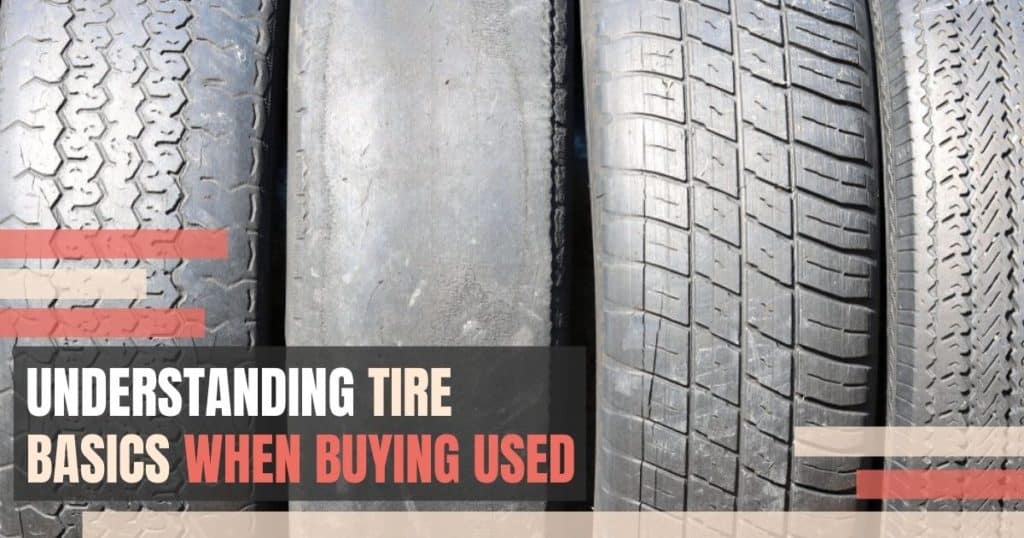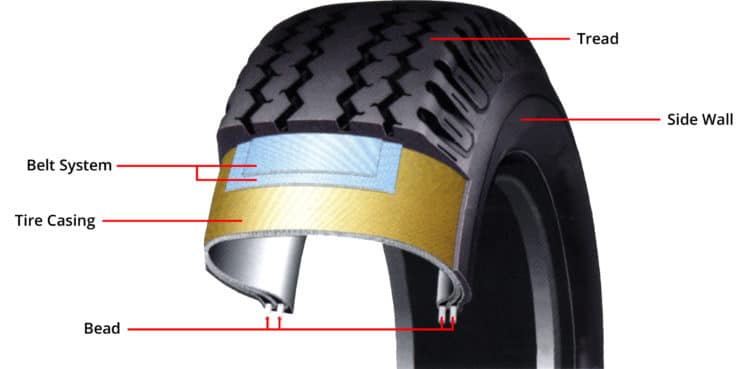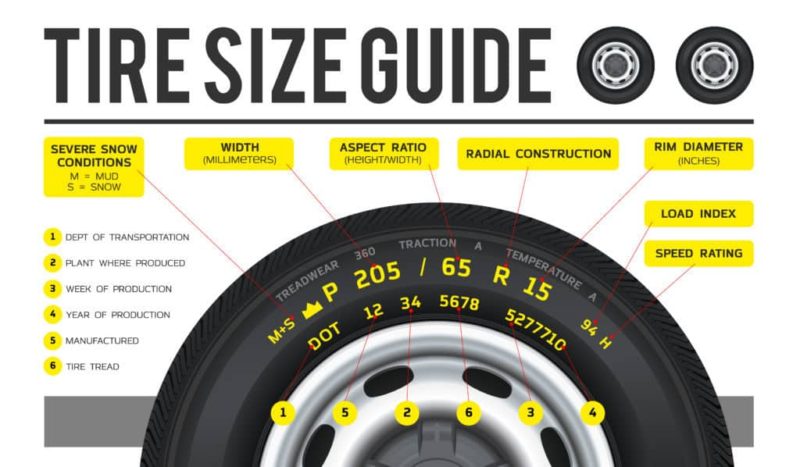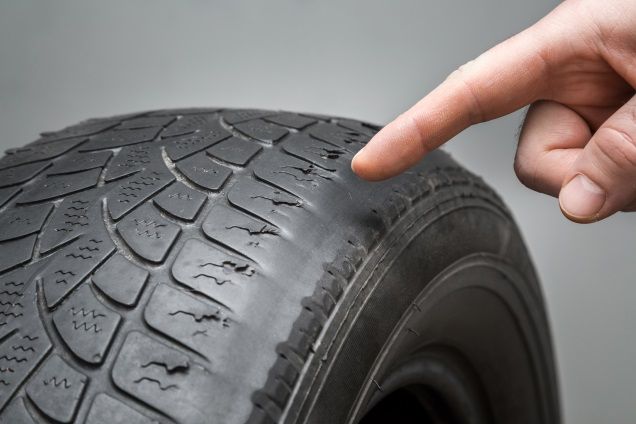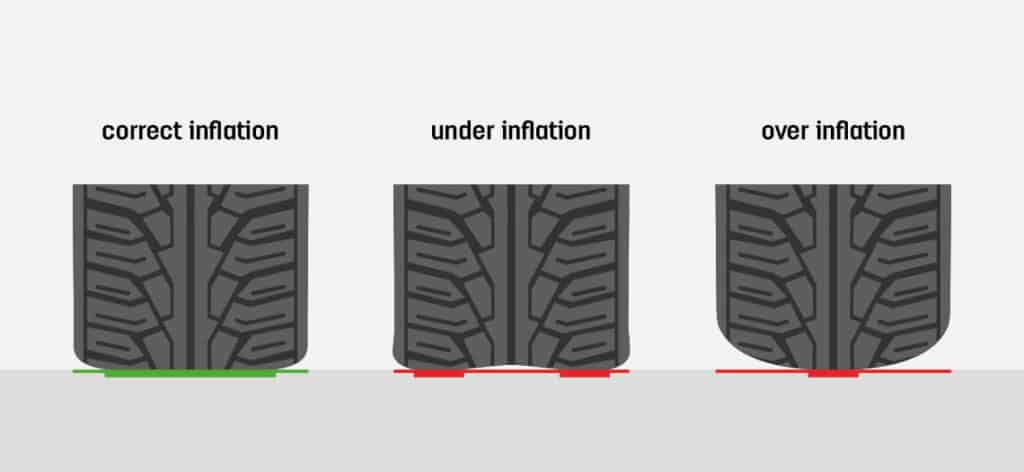A tire is simply a rubber container inflated with compressed air. Its purpose is to support the weight of the vehicle; advance the vehicle frontward, backward, or to the sides; stop the vehicle; and provide a shock absorption from imperfections in the road. To really understand how a tire works you must first grasp some tire basics,
Used Tire Basics 101
Tires can have as many as 25 different components, depending on the brand or type. Here are the basics :
The main component is the inner liner. This provides the tires shape and creates a container for the compressed air. The inner liner is then wrapped with fabric belts (tire casing) and at the bottom the bead is fastened, which is what holds the tire to the rim. Steel belts (Belt System) lay across the top of the fabric belts. The steel belt serves two primary functions. First it provides the tire with stability. Secondly it keeps the tread pattern flat (the flatter the tread the more contact it has with the road). On type of the steel belts is the actual tread pattern, which is what you see on the outside. Different tire types require different tread patterns. The tread is what provides grip, while the sidewall provides ride characteristics and stiffness.
TIP: A shorter, stiffer sidewall will offer better cornering and steering responsiveness, while a taller, softer sidewall will absorb bumps much better.
Every tire for a passenger car or light truck has an alphanumeric code printed on it. These codes describe the attributes of the tire. Most tires start with the letter “P” or “LT”. “P” means passenger car and “LT” means light truck. You may also find a “Max Load” label on the sidewall. Extra Load tires will be marked “Extra Load” and may have an “XL” (for example: LT245/ 75R15 XL).
TIP: When purchasing tires it is imperative to select a tire’s whose “Max Load” is equal of greater to the tire you intend to replace.
How to Choose The Right Tire For Your Vehicle
The most common mistake people make with used tires is buying the wrong size for the vehicle. To find out the size and characteristics of the tire, look at the sidewall for an alphanumeric code. This code exists on tires made for passenger vehicles and lite trucks, not for heavy duty tires.
It will look something like this:
P190/60R16 63H M+S
- P – Type of tire (in this case “P” for passenger vehicle)
- 190 – Width of the tire measured across the tread in millimeters (mm)
- 60 – Aspect ratio of the sidewall as compared against the tire width
- R – Radial construction (aka radial-ply)
- 16 – Diameter of the rim in inches (in)
- 63 – Tire’s load rating
- H – Tire’s speed rating
- M+S – Tire is suitable for all-season driving
Type
As mentioned earlier, if the tire code starts with “LT” instead of “P”, then it is for a light truck vehicle class. LT’s offer the ability to bear a heavier weight capacity. These are the tires you might find on standard pick up trucks and SUV’s, all though it’s not always required. Many of these vehicles are built to specifications for “P” tires.
P and LT tires are extremely different. Owners of pick up trucks and SUV’s might choose a P tire for its affordability and less bumpy ride. On the contrary if you are constantly loading your pickup or SUV with heavy loads and/or trying to pull a trailer, then an LT tire is much better suited.
Load Rating
One of the most important attributes of the tires code is load rating. The load rating is a numerical representation of the load carrying capacity of just that one tire. In other words, how much weight can one tire hold. It is important to choose tires with correct load rating for your vehicle.
Speed Rating
Another important factor is the speed rating. The speed rating, which most commonly can be an “H” or a “T”, is not what you may think. These refer to the tires ability to dispel heat or prevent the heat from building up. When a tire gets hot, it wears down faster and increases the likelihood of breakdown. The higher the speed rating, the more heat the tire can withstand and dissipate. This would be a factor in choosing tires if you do a lot of long trips on the highway. If you mostly do local driving speed rating shouldn’t be a decision factor for you in picking out a tire. For more info about how fast you can drive on your tires, read here.
Speed ratings fall between 99 to 186 mph (159.3 to 299.3 kph). The two most popular speed ratings are “T” which equates to 118 mph (189.9 kph) and “H” which equates to 130mph (209.2 kph). Obviously these speed ratings are higher then the national posted speed limits on highways, which makes them ideal for long distance highway driving. If you drive locally only, then a speed rating of “S” which equates to 112 mph (180.2 kph) might be a better more affordable choice.
Weather Condition Type
No matter the load rating or the speed rating, a tire’s safety lies in the traction, size and construction. Nothing is more important than a tires ability to grip the road. If you are smart and want the best approach to traction you should balance your tires every time the conditions change. For example if you live where it snows a lot then a “winter tire” is best for the winter, but if you live wear its always warm, then a “touring” tire will be great. To learn more read here.
Many people procrastinate on seasonal tire purchasing either because of inconvenience or cost. There is a strong market trend of people waiting to purchase tires in the spring. This backwards logic…when a tire wears out dry condition traction increases, while wet/snow traction decreases. So really the best time to get new tires in in the fall season.
Properly Evaluating a Used Tire for Safety
When you find the right size you need. The next thing you need to do is carefully inspect the tire for several factors. The two factors that stand out as most critical in your buying decision or tread wear and tire age. The NHTSA recommends that you never buy a tire more than six years old, because that’s when the rubber starts to rot. So even if an older tire has no tread wear, don’t buy it because t is unsafe.
Here are the main things to consider when inspecting a second hand tire:
- Tread Depth – 2/32 of an inch and below is bald by law
- Exposed Chords – There shouldn’t be any metal chords showing through the rubber on the tread or sidewall
- Chunking Beads – Look for chunks of rubber missing around the bead
- Separated Belts – Use your hand to feel for waviness in the sidewalls
- Aging – Never buy tires over six years old, check the TIN
- Improper Repairs – Punctures, plugs, patches are all potential safety issues
- Linear Damage – Examine inside the inner for metal wires poking out
For more in depth descriptions of each of these evaluation points, read here. It’s also good to be aware of used tire scams such as re-grooving and scratching of the DOT codes so you can’t assess the tires age.
If the wheel is still attached to the tire, it is also important that wheel isn’t bent or shows signs of structural damage. Used car and truck rims that aren’t straight are just as dangerous as bald tires.
How and Where You Drive Affects the Tire
When you are ready to get a set of used tires for your vehicle, you should consider the following:
- The type and size of tire recommended by the manufacturer (should be in your owner’s manual)
- What are you looking for based on your needs? What kind of driving do you do normally? Highway or Local? Do you want a firm ride, soft ride, or a bit of both?
- Are there any special load requirements your tire needs to meet? Are you using your pick up truck to carry high capacity loads? If so you need a light truck tire.
- How much tire do you need? Most people often overestimate their tire requirements and over spend. For the most part a quality all weather tire will do.
- Remember all tires are different and each will balance the quality of ride, noise from the road, fuel economy, tread wear, load capacity, and price differently. Its up to you to decide what you are looking for in a tire and articulate that to a service manager at the tire shop.
- Do you care about the look of your tires? Recently an auto trend is “super sizing” your tires. This is when you mount larger tires then your vehicles requirements. People like the look of the larger tires, plus there is some improved handling because of increased cornering and traction. It comes at the expense of a rougher ride and more wear on the tire.
If you are interested in “super sizing” here are a few tips:
- The wheel and tire still need to meet the requirements of your vehicle.
- The load capacity needs to be the same or higher than your vehicles requirements
- The super sized tire should be about 3% +/- from the orig tire diameter
- Update the tire placard on the inside of your door to remember the appropriate tire pressure
Tires Play a Major Role in Fuel Consumption
Fuel consumption can be increased or decreased based on your choice of tire. If you went with a radically different set of tires then the 4 that were on your car when it was new, you will affect the fuel economy in either a positive or negative way.
Bill VandeWater at Bridgestone said that, “consumers can see a 15 to 20 percent difference in their fuel economy depending on the tire they select.” That 15 to 20% swing can be a huge cost increase or savings over the life of a set of tires. The truth is though most motorists don’t consider fuel economy when making tire purchases. This is especially true in the second hand tire market where we look for affordability and quick fixes. In the used tire market you are dealing with tires that are already worn and not performing at their peak for being fuel efficient.
The best way to ensure your used tires perform fuel efficient is to make sure they are properly inflated. You should perform routine checks to monitor your air pressure. You can find the manufacturers PSI recommendation in your owners manual. There are places you get free air for tires if you need them inflated.
Proper inflation is critically important because:
- It creates less heat with the road, increasing fuel economy and decreasing tread wear.
- If it’s over inflated or under inflated it causes uneven tread wear.
- The ability to corner smoothly is affected when the sidewall isn’t stiff enough.
- The load capacity decreases as the tire has less air pressure which creates more heat in the tire
In addition to inflation, alignment, rotation, and balancing also play a factor. You can read about common tire services here.
Tire Basics 101
In general understanding tires will make you a better and safer driver. When it comes to buying used tires understanding tire basics is even more critically important. Used tires can potentially be dangerous. If you do not properly evaluate them you could be putting yourself at risk. When purchasing used, never choose a good deal over a good tire. Tire health is more important than a good price.
